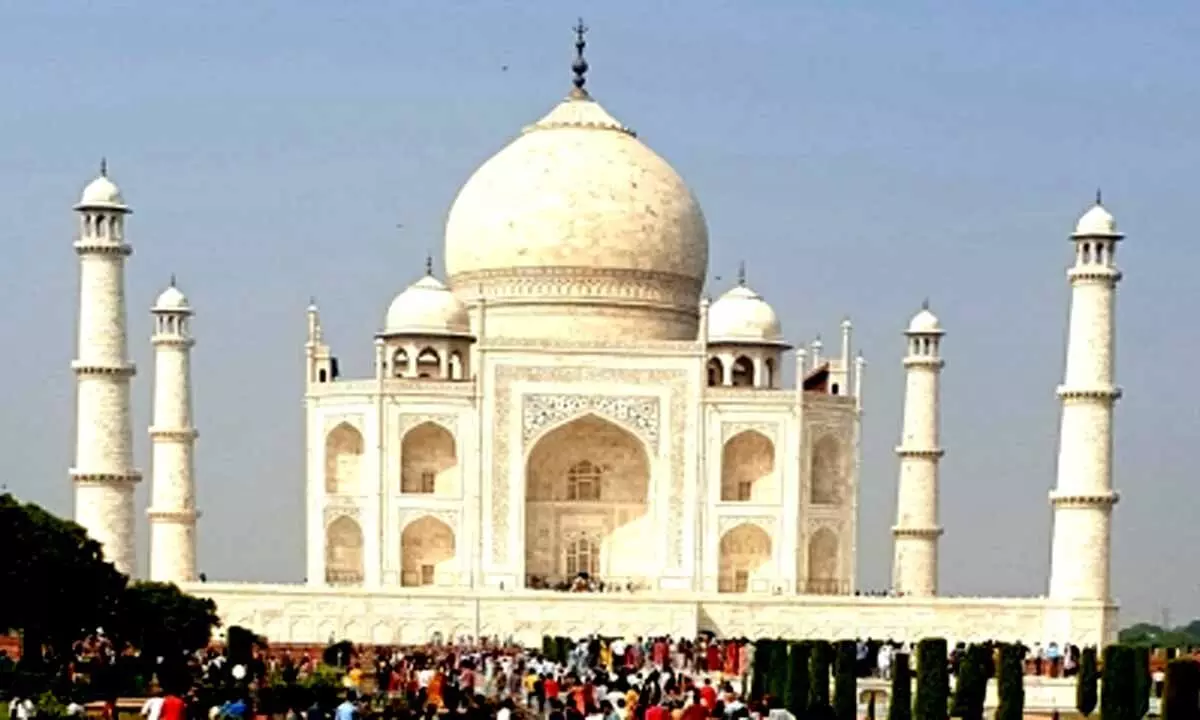Insects breeding on dry polluted Yamuna riverbed a threat to Taj Mahal's beauty
Share :

Even as a new tourist season has just picked momentum, an alarm has again been sounded on the growth of insect/bacterial colonies on the white marble surface of the Taj Mahal, the 17th-century monument of love, designated as a world heritage site.
Agra: Even as a new tourist season has just picked momentum, an alarm has again been sounded on the growth of insect/bacterial colonies on the white marble surface of the Taj Mahal, the 17th-century monument of love, designated as a world heritage site.
As in previous years, the dry and polluted riverbed has enabled the proliferation of mosquitoes, insects, and bacteria that settle on the surface of the Taj facing the river. "These green patches are periodically cleaned by the ASI staff, but the stink and "visually-unfriendly" spots reappear at a regular frequency," according to tourist guide, Ved Gautam.
Last year the National Green Tribunal (NGT) instructed local authorities to ensure that the breeding grounds of insects on the Yamuna River bed were cleaned, but the agencies responsible expressed helplessness, as the river was dry and heavily polluted with effluents, sewer waste, and toxics. "Unless there is a regular flow of fresh water in the river, how can this problem be managed," they ask.
"What flows in the name of water, is actually poison, polluted liquid, with zero Oxygen level and a very high concentration of chemicals, trace elements, some carcinogenic," says environmentalist Devashish Bhattacharya. The local administration has been organising cleanliness drives but till there is water in the river, the pollutants can not be diluted and water made safe, Bhattacharya adds.
River Connect Campaigners in Agra lament the cold apathetic response of the Yogi Adityanath government towards cleaning the Yamuna River which needs immediate dredging and desilting. In 2013 Prime Minister Narendra Modi promised to clean up the Yamuna in the Braj Mandal. Later on several occasions union minister Nitin Gadkiri had talked of launching a ferry service between Delhi and Agra for the tourists. "But promises have not been kept and the river, once the lifeline of the Braj Mandal, has been reduced to a vast sewage canal," said river activist Padmini Iyer.
The Yamuna River, as it enters the Braj Mandal, upstream of Vrindavan, is already sick and pale with waste and industrial effluents from Delhi and Haryana industrial clusters. The Gokul Barrage in Mathura, stores only polluted and stinking water, because drains have not been tapped and discharges are untreated before opening into the river," adds Jagan Nath Poddar of the Friends of Vrindavan.
Clearly, in addition to desilting and dredging on a massive scale, what is required is a mechanism to monitor and ensure regular flow of fresh water into the Yamuna, from upstream barrages.
According to experts and campaigners for clean rivers, a major hindrance to the cleaning of Yamuna River remains the inadequate flow of water particularly in the long dry season, which now extends up to eight months in a year.
The National Green Tribunal and the Supreme Court of India have repeatedly stressed maintaining a minimum level of flow in the river to keep it alive and safe for aquatic life and also for cleaning, but the state governments and the regulatory bodies have failed to ensure uninterrupted flow of fresh water downstream of barrages in Haryana.
A parliamentary committee, two years ago blamed the poor flow of water downstream of Wazirabad in Delhi, which impeded the cleaning of the Yamuna river that had been tasked to determine the environmental flow along the line of the Ganges river to maintain Yamuna's good health. The committee said both the Central and the Delhi governments should work in close collaboration to clean Yamuna.
Some other factors were the illegal discharge of sewage and industrial effluent, disposal of solid waste in drains, improper functioning of CETPs (common effluent treatment plants), and insufficient sewage treatment capacity. It may be recalled that a memorandum of understanding (MoU) was signed by the chief ministers of Himachal Pradesh, Haryana, Uttar Pradesh, Rajasthan, and Delhi on May 12, 1994, regarding the allocation of utilisable surface flow of Yamuna up to Okhla Barrage (Upper Yamuna) among the co-basin states.
According to the terms of this memorandum, a minimum flow in the proportion of completion of upstream storages going up to 10 cumecs shall be maintained downstream of Tajewala and Okhla Headworks throughout the year from ecological considerations, as upstream storages are built up progressively in a phased manner. The Principal Bench of the National Green Tribunal (NGT) had also directed that Haryana shall release 10 Cumec (352 cusecs) water directly into the main stream of Yamuna river from Hathinikund Barrage and maintain the e-flow of the river till Wazirabad.
In terms of the stipulations laid down in the 1994 memorandum storage capacity among the States for maintaining minimum flow in the Yamuna river throughout the year has not been built so far. The concerned departments of the Central and the state governments have also noted that poor and inadequate flow at Wazirabad during the dry period was one of the major issues that impeded the cleaning of the Yamuna.
The parliamentary committee, therefore, recommended that all-out efforts in cooperation with the concerned States to build the storage capacity be made urgently. Several expert groups have urged the government to finally define the e-flow quantity for the Yamuna, as has been done in the case of the river Ganges, to maintain the health of the river and its ecosystem.
River activists in Agra demand a clear-cut national rivers policy and a time-framed action programme to save the dying Yamuna river, integral to Hindu mythology and tourism in the Agra region. "Most Mughal monuments from Delhi to Agra are sited along the banks of the Yamuna, therefore if the Yamuna river remains dirty, dry, and polluted, there is cause for worry and alarm," adds Rajiv Gupta, Lok Swar president.
















